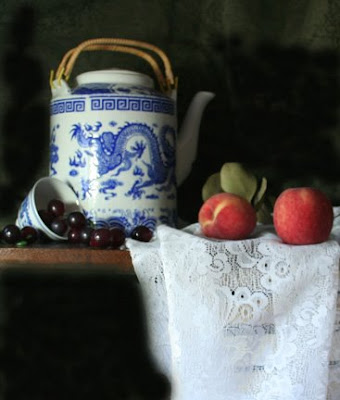 I recently spent a weekend in Victoria visiting with some friends. An afternoon jaunt to China Town netted me this lovely Tea Pot. I fell in love with the dragon. With summer nearly here and other demands calling for my attention, I thought I'd spend the entire day on this painting and see what the investment in time on a single sitting could yeild.
I recently spent a weekend in Victoria visiting with some friends. An afternoon jaunt to China Town netted me this lovely Tea Pot. I fell in love with the dragon. With summer nearly here and other demands calling for my attention, I thought I'd spend the entire day on this painting and see what the investment in time on a single sitting could yeild.Here's the set up. I ended up changing a few things once I began the layin.
I love to paint lace and it's always a challenge to make it come out right. I nearly always have to remind myself to take my time on it. I'm always glad when I do.
I started the painting with a basic monochromatic underpainting using some acrylic black and white. I wanted to get a feel for the light in this piece and a good value study is always helpful. You can see that I kept things pretty loose and used a relatively large brush. I avoided details and just kind of played
with how I wanted the brush strokes to go.
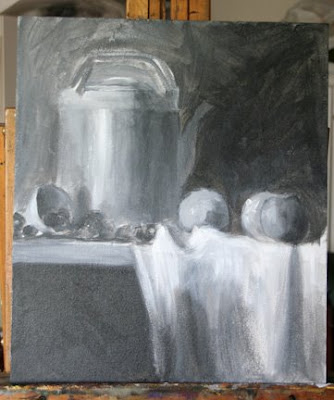 That's one of the cool things about working with acrylic at this stage. You get to see how things will play out. The lighting for the background was a bit tricky. I wanted it to be atmospheric and not too dark. But I didn't want it chalky either. I knew the transitions would be important.
That's one of the cool things about working with acrylic at this stage. You get to see how things will play out. The lighting for the background was a bit tricky. I wanted it to be atmospheric and not too dark. But I didn't want it chalky either. I knew the transitions would be important.In the next picture you can see that I've laid in a background mixed from burnt umber, cad yellow and a touch of naples yellow for the lighter hue. I've blended that with a darker mix that has a bit of ultramarine blue and no naples yellow in it.
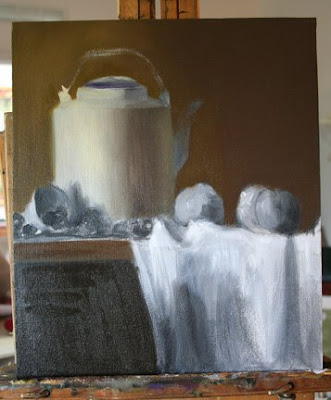 I smoothed out the brush strokes with a very soft black sable Performen brush. I love these brushes. They have a multitude of uses and cost relatively little compared to other sables. ASWexpress.com carries them.
I smoothed out the brush strokes with a very soft black sable Performen brush. I love these brushes. They have a multitude of uses and cost relatively little compared to other sables. ASWexpress.com carries them.Here you can see that I started with the base color of the tea pot. I've used titanium white, naples yellow, some background color and a touch of ultramarine blue. This is mixed in three shades from light to dark. I'm very careful to conserve the lightest light which will be used later for highlights on the pot.
A good thing to do when you are painting a light colored piece (or any color for that matter) is to squint down and compare the value of the object right next to the highlight. You'll be surprised at just how dark by comparison it really is.
Now the peaches. First I mixed the shadow color using a bit of alazarin crimsen and sap green. I pushed this into the shadows of the fruit. Next I mixed a light mixture of cad yellow deep, cad light, background green and naples yellow - keeping the mixture light and not trying to over mix it. Stir it together on your palette like you are making muffins. Too much mixing and the muffins go flat.
Things are not too defined here and I'm keeping my edges soft. I'm looking for value changes and just trying to make sure that things stay where they are supposed to. There's actually three peaches on the right. One in front of the other and I'm struggling here to get one pushed back and the other brought forward.
A note about edges. Edges are like the marks on a music sheet telling the musician when to go slow and when to go fast. You edges are supposed to act as guides to the viewer, signaling them as to the pace of the painting. Your job is to conduct the symphony and lead the viewer where you want them to go. But it's best to leave all your edges soft until you get to near the end stages. Then you can adjust edges with a little more authority.
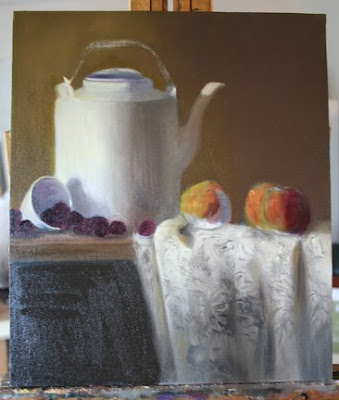 Here comes the lace. I thought a lot about what I was doing here so that I could explain it to you as I go along.
Here comes the lace. I thought a lot about what I was doing here so that I could explain it to you as I go along.Basically, when you paint lace - and this goes for almost any medium, you paint the holes first. After laying in the cloth with a similar mixture to that of the tea pot, I took a bit of raw umber and background mixture and then took a soft brush and kind of stippled in the designs of the lace where the holes were. Don't worry too much about getting all the detail. If you get started with a basic pattern, just repeat it with a few variations making sure to follow the folds of the cloth. Pay attention to the lights and darks (overall values) on the cloth. You don't want to go light where you should go darker.
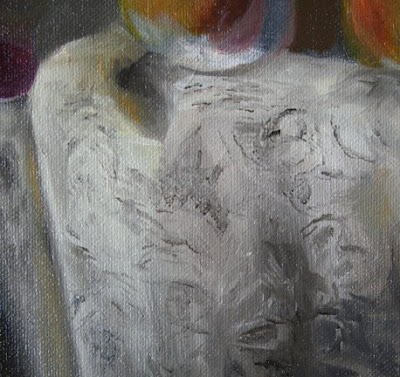
A note here about brush strokes. David Leffel (my hero), says that you should not be able to hear the stroke of the brush on the canvas. If you can you either don't have enough paint on the brush or you don't have enough medium on it. You should practice getting just the stroke you want with a loaded brush. A deliberate stroke that is not correct will look 100 times better than a correct passage that is overworked. This takes practice. Lots of it. So get your paints out and start painting a piece of fruit a day. By the end of the year, you'll either be fat as a cow from eating your leftovers or you'll be a genius at laying in paint. Or maybe both, but it will be worth it.
Ok. Here you can see the lights a bit better. Now that lace is starting to come to life. Now it's time to fix those poor peaches.
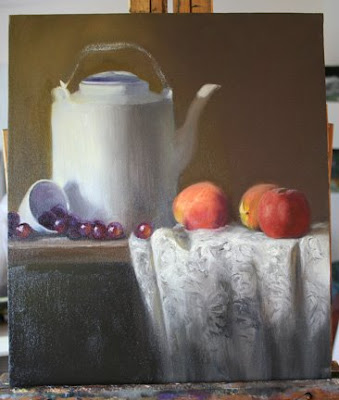 Placement is important here so I push the one in the back further against the background and reduce it's size a bit with background color and some adjustments to the cloth. This peach is furthest back and so it needs a soft edge where it meets the background color. I dragged some of the green down into it and soften the edge with my brush. The edge against the pot is a bit harder. I want a little air there between the peach and the pot. The colors are mixed with cad red light, cad yellow deep and cad yellow light. Not all mixed together, mind you, but in subtle ways to bring the color of the peach out. To turn the edge, I've used some of the back ground color and alazarin crimsen where the light turns to the shadow side.
Placement is important here so I push the one in the back further against the background and reduce it's size a bit with background color and some adjustments to the cloth. This peach is furthest back and so it needs a soft edge where it meets the background color. I dragged some of the green down into it and soften the edge with my brush. The edge against the pot is a bit harder. I want a little air there between the peach and the pot. The colors are mixed with cad red light, cad yellow deep and cad yellow light. Not all mixed together, mind you, but in subtle ways to bring the color of the peach out. To turn the edge, I've used some of the back ground color and alazarin crimsen where the light turns to the shadow side. The second peach also needs to be back a bit but not as far back as the formost peach. I've added a bit of green to the mixture. The peach fuz on the top is a mixture of cobalt blue and a bit of white. I've kept it's top edge soft and the left edge a bit sharper.
I've added color to the grapes. A bit of blue (cobalt & white) for some reflection and a bit of cad yellow and rose for the areas of the grape where light shines through. The highlights are thick and I've run the end of my brush through them to add texture.

The handles have been ignored until now so it's time to give them a little attention. This is a simple mixture of yellow ochre. I've laid them in here with a bright brush to keep the square look I'm after.
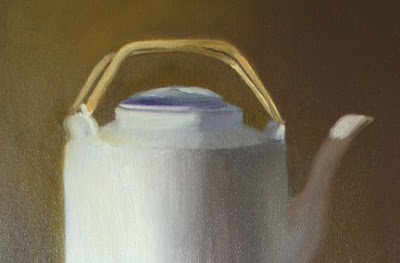 Lastly, I take a bit of umber softened with background green and make tiny little lines to indicate the weave pattern on the handles.
Lastly, I take a bit of umber softened with background green and make tiny little lines to indicate the weave pattern on the handles.I'm really grateful for those life drawing groups I go to every Tuesday. All that sketching has paid off and allowed me to get the dragon in fairly accurately without a lot of fuss. If you are trying something like this, I would suggest that you first let the white paint dry. If it's dry, you can make all the mistakes you want because you can just wipe out the glaze and start over. Here my paint was still wet so not only could I not afford a mistake, I needed to lay the glaze on with short light strokes so as not to disturb the wet paint underneath.
After the dragon was finished, I put the design along the top edge of the pot in. I changed it from the design on the original pot to something simpler (my back was killing me).
From this point on, I adjusted edges, checked measurements and put in the leaves behind the fruit. Oh, yeah...notice the highlight in the final photo. See how light it looks against what you thought was a really light pot?
Phew. An all day painting session, but it paid off. What do you think?
Oh. Just a note here...I appreciate your comments on the blog but I'd like you all to feel free to start a dialogue where you can learn from one another too. Feel free to post and ask questions of each other.





No comments:
Post a Comment